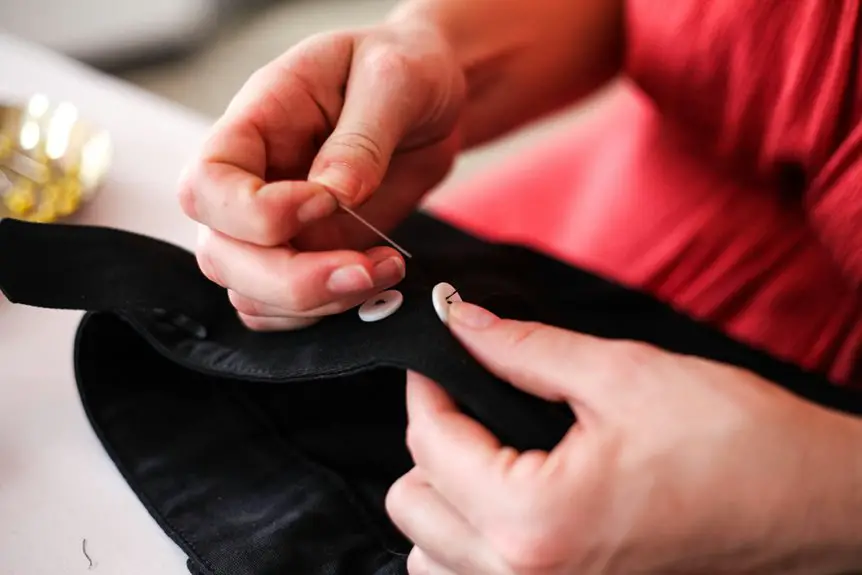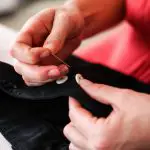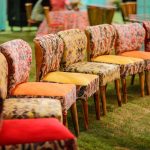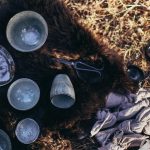You’ll notice lawn fabric feels smooth and slightly crisp, thanks to its tight weave and medium weight, making it great for structured summer clothes. Batiste, however, is lighter, softer, and more delicate with a looser weave, perfect for lingerie or baby clothes. Both are mostly cotton, but lawn sometimes mixes in linen, while batiste can include synthetics for durability. If you want to pick the best fabric for your project, there’s more to explore about their uses and care.
Table of Contents
Key Takeaways
- Lawn fabric has a tight, plain weave making it smooth and crisp, whereas batiste features a looser weave for a softer, delicate texture.
- Lawn is generally heavier and thicker (90-120 g/m²) compared to the lighter, thinner batiste (70-90 g/m²).
- Lawn fabric feels cool and slightly stiff, ideal for structured garments; batiste is softer and more pliable, suited for draping.
- Lawn is commonly used for summer dresses and blouses, while batiste is preferred for lingerie, baby clothes, and handkerchiefs.
- Batiste often includes synthetic blends for durability and is pricier, whereas lawn is mostly cotton or linen and moderately priced.
Origin and History of Lawn Fabric and Batiste
Although both lawn fabric and batiste have been around for centuries, their origins reflect different cultural and industrial influences.
Lawn and batiste, centuries-old fabrics, reveal distinct cultural and industrial heritage shaping their unique qualities.
When you explore lawn fabric, you’ll find it began in the 18th century, named after the Irish town of Loughborough, where skilled weavers crafted this smooth, crisp cloth. It gained popularity for summer wear due to its lightweight, breathable nature.
On the other hand, batiste’s roots trace back to France, where it emerged as a fine, soft fabric favored for delicate garments and handkerchiefs. Unlike lawn, batiste was prized for its sheer, almost silky texture.
Understanding these backgrounds helps you appreciate why lawn suits casual, airy styles, while batiste fits more refined, delicate applications.
Both fabrics have evolved, but their historical contexts still influence their uses today.
Fiber Content and Material Composition
You’ll find that both lawn fabric and batiste are usually made from fine cotton fibers, but their blends and treatments can vary.
Understanding the fiber types helps you grasp how each fabric behaves regarding texture and durability.
Let’s compare their material properties to see what sets them apart.
Fiber Types Overview
When choosing between lawn fabric and batiste, understanding their fiber content is essential because it directly affects texture, durability, and breathability.
Both fabrics often use natural fibers, but their blends and purity vary, influencing how they feel and perform.
- Cotton: Mainly used in both, cotton offers softness and excellent breathability, making it ideal for warm weather garments.
- Linen: Sometimes blended into lawn fabric, linen adds strength and a crisper texture, enhancing durability.
- Synthetic Blends: Occasionally, batiste includes polyester or other fibers to improve wrinkle resistance and longevity without compromising lightness.
Knowing these fiber types helps you pick the right fabric for your project, balancing comfort and practicality.
Material Properties Comparison
Understanding the fiber types gives you a foundation to compare lawn fabric and batiste regarding their material properties.
Lawn fabric usually consists of fine, high-quality cotton or cotton blends, which makes it lightweight yet durable. Its tight weave guarantees a smooth texture with slight crispness, perfect for summer clothing.
On the other hand, batiste is also made from cotton or cotton blends but often incorporates finer yarns and a looser weave, resulting in an even softer, more delicate fabric.
While both fabrics are breathable and comfortable, lawn fabric offers more structure, whereas batiste feels silkier against your skin.
Knowing these differences helps you choose the right fabric based on the garment’s intended look and feel—whether you want a crisp finish or a gentle drape.
Weave and Texture Differences
Although both lawn fabric and batiste share a fine, lightweight quality, their weaves and textures set them apart distinctly.
Lawn fabric and batiste are both fine and lightweight, yet differ notably in weave and texture.
When you choose between them, consider these key differences:
- Weave Structure: Lawn fabric uses a plain, tight weave that creates a smooth, crisp surface. Batiste features a slightly looser weave, giving it a softer, more delicate feel.
- Hand Feel: Lawn feels cool and slightly stiff to the touch, making it great for structured garments. Batiste is softer and more pliable, ideal for draping and comfort.
- Surface Texture: Lawn’s texture is smooth with a subtle sheen, while batiste often has a matte finish with a gentle fuzziness.
Knowing these distinctions helps you pick the right fabric for your project’s texture and look.
Weight and Thickness Comparison
Since weight and thickness greatly affect how a fabric behaves, it’s important to know how lawn and batiste compare in these aspects. Lawn fabric typically has a slightly heavier weight and thicker feel than batiste, making it more durable while retaining softness. Batiste, being lighter and thinner, offers a delicate touch suitable for fine garments. Understanding these differences helps you choose the right fabric for your project.
| Fabric Type | Weight (g/m²) | Thickness (mm) |
|---|---|---|
| Lawn | 90-120 | 0.15-0.20 |
| Batiste | 70-90 | 0.10-0.15 |
This table summarizes the typical ranges, guiding you to select based on your needs for sturdiness or lightness.
Sheerness and Transparency Levels
When you choose between lawn and batiste, consider how sheer or transparent you want your fabric to be. Both fabrics are lightweight, but their sheerness differs, affecting your project’s look and feel.
- Lawn fabric tends to be more transparent, giving a crisp, airy appearance that’s perfect for layering or when you want a delicate, breathable finish.
- Batiste is slightly less sheer, offering a soft, smooth texture with just enough opacity to provide modest coverage without losing lightness.
- If you need a fabric with subtle transparency, batiste works well; for a more translucent effect, lawn is your best bet.
Understanding these transparency levels helps you pick the right fabric to suit your style and comfort needs.
Common Uses and Applications
Both lawn fabric and batiste find frequent use in warm-weather clothing, but they each bring unique qualities to different projects.
You’ll often choose lawn fabric for items like summer dresses, blouses, and lightweight shirts because of its slight crispness and durability. It holds shape well, making it ideal if you want a structured yet breathable garment.
Batiste, on the other hand, suits delicate pieces such as lingerie, baby clothes, and handkerchiefs thanks to its softness and fine weave.
If you’re working on curtains or lightweight scarves, both fabrics can work, but lawn’s smooth finish gives a polished look, while batiste offers a more ethereal appearance.
Understanding their characteristics helps you pick the right fabric to match your project’s style and function.
Care and Maintenance Tips
You’ll want to follow specific washing instructions to keep both lawn fabric and batiste looking their best.
Proper storage is key to prevent wrinkles and damage over time.
Handle these delicate fabrics gently to maintain their softness and durability.
Washing Instructions
Although lawn fabric and batiste may look similar, their delicate fibers demand different washing methods to keep them in top condition.
When you wash lawn fabric, handle it gently but confidently, while batiste requires even more care to avoid damage.
Here’s how you can wash both fabrics effectively:
- Lawn Fabric: Use cold water and a mild detergent. Hand wash or choose a gentle cycle if machine washing. Avoid wringing to prevent distortion.
- Batiste: Always hand wash in cold water with a delicate detergent. Don’t twist or wring; instead, press water out gently.
- Drying: Lay both fabrics flat on a clean towel to air dry. Avoid direct sunlight to prevent fading and fiber weakening.
Follow these steps, and your fabrics will stay fresh and beautiful.
Storage Recommendations
After washing, proper storage plays a key role in preserving the quality of lawn fabric and batiste. To keep both fabrics looking their best, store them in a cool, dry place away from direct sunlight to prevent fading and weakening. Avoid plastic bags, which can trap moisture and cause mildew. Instead, opt for breathable cotton storage bags or wrap the fabric in acid-free tissue paper.
| Storage Tip | Lawn Fabric |
|---|---|
| Location | Cool, dry, away from light |
| Wrapping | Acid-free tissue or cotton |
| Folding | Neatly, avoid sharp creases |
| Avoid | Plastic bags, damp areas |
| Check regularly | For pests or mildew signs |
Following these tips guarantees your fabrics stay fresh and durable.
Handling Delicate Fabrics
When handling delicate fabrics like lawn and batiste, treating them gently will extend their lifespan and maintain their softness.
You want to avoid rough treatment that can cause snags or wear. Here are three essential care tips:
- Hand wash or use a gentle cycle: Use cold water and mild detergent to protect fibers and colors.
- Avoid wringing or twisting: Instead, press out water carefully or roll the fabric in a towel to dry.
- Iron on low heat with a pressing cloth: This prevents scorching and preserves the fabric’s delicate texture.
Availability and Price Range
Since lawn fabric and batiste serve different purposes, their availability and price range can vary considerably.
You’ll find lawn fabric widely available at fabric stores and online, thanks to its popularity for summer clothing and light curtains. It generally falls into a moderate price range, making it accessible for most projects.
Batiste, being a finer, more delicate fabric often used for luxury garments and lingerie, tends to be less common in regular stores but easier to find in specialty or high-end fabric shops.
Because of its delicate nature and quality, batiste usually comes with a higher price tag.
When shopping, you’ll notice lawn fabric is budget-friendly and plentiful, while batiste requires a bit more investment and searching to locate the right quality.
How to Choose Between Lawn Fabric and Batiste
How do you decide whether lawn fabric or batiste is best for your project? Consider your specific needs carefully:
- Texture and Feel: If you want a crisper, slightly more textured fabric, lawn fabric is ideal. For a softer, smoother touch, batiste works better.
- Project Type: Choose lawn for lightweight shirts, dresses, or curtains where durability matters. Opt for batiste when you need delicate lingerie, baby clothes, or fine blouses.
- Breathability and Sheerness: Both are breathable, but lawn tends to be a bit sheerer. If you want something less transparent, batiste might be your best bet.
Frequently Asked Questions
Can Lawn Fabric or Batiste Be Used for Upholstery?
You shouldn’t use lawn fabric or batiste for upholstery because they’re lightweight and delicate. Instead, choose heavier, more durable fabrics designed to withstand wear, so your furniture stays looking great and holds up over time.
Are Lawn Fabric and Batiste Suitable for Summer Bedding?
You’ll find both lawn fabric and batiste great for summer bedding since they’re lightweight and breathable. They’ll keep you cool and comfortable during warm nights, making them perfect choices for hot weather.
Do Lawn Fabric and Batiste Shrink After Washing?
Think of fabric like a living creature—it can change after its first bath. Both lawn and batiste might shrink slightly when washed, so you’ll want to pre-wash them to keep your garments fitting just right.
Can Lawn Fabric or Batiste Be Dyed at Home?
You can dye both lawn fabric and batiste at home, but lawn fabric absorbs dye better due to its coarser weave. Use fiber-reactive dyes and follow instructions carefully for vibrant, even colors on either fabric.
Is Either Fabric Hypoallergenic for Sensitive Skin?
You’ll find both lawn fabric and batiste are generally hypoallergenic since they’re made from natural fibers like cotton. They’re gentle on sensitive skin, but it’s smart to check for any added chemicals or finishes before buying.
- Tetron Fabric for Marine Applications: Durability and Use Cases - June 18, 2025
- Tetron Fabric for Outdoor Furniture: Weather Resistance and Care - June 18, 2025
- Tetron Fabric for Wall Coverings: Style and Application Tips - June 18, 2025






